October – December 2022 Edition | Volume 2, Issue 4
The ANPAD Annual Meeting (EnANPAD) is one of the most relevant annual congresses in the field of administration, accounting, and related sciences and has been held for over four decades.
It is a space for dialogue among peers encouraging in-depth debates and interaction connecting participants, speakers, and international guests. In the past years, the event has gathered annually around 2,000 participants. Since its first edition, it has hosted more than 30,000 participants.
The 46th EnANPAD was held online from September 21 to 23, 2022, and addressed the theme “Tackling grand societal challenges: A role for management, managers, and organizations.”
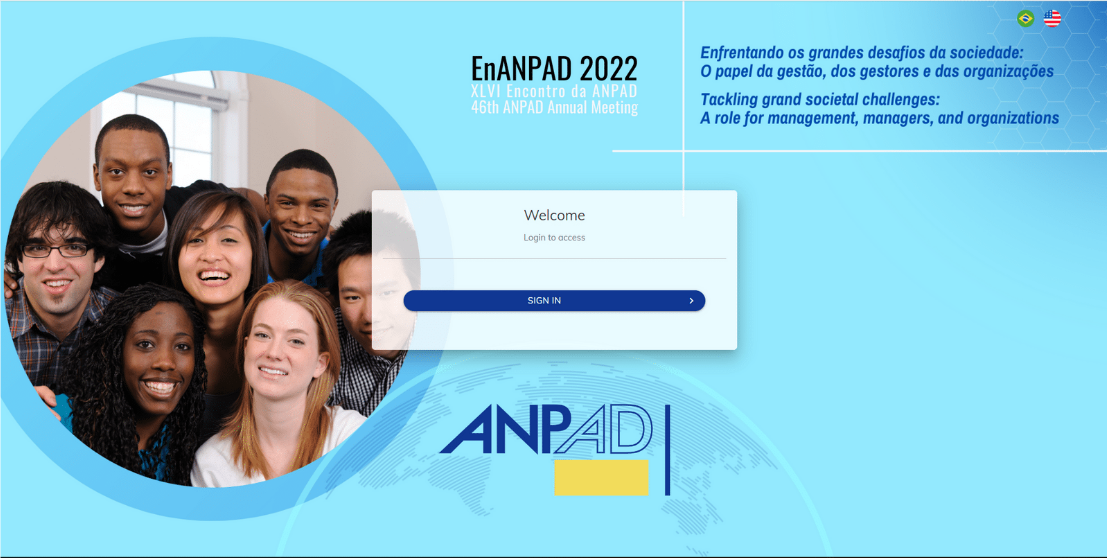
The event was preceded by the 16th IFSAM Congress (promoted by the International Federation of Scholarly Associations of Management from September 7 to 9) and the Methodological Development Workshops and Doctoral Consortium (September 12 and 13).
The format of the presentation of papers favored the in-depth debate and the participants’ interaction. The event counted 367 presentation sessions and 61 activities (interdivisional and promoted by ANPAD’s academic divisions), 25 of which received international guests. Over 40 international speakers from countries such as South Africa, Australia, Canada, Spain, the United States, Finland, England, Mexico, Wales, the Netherlands, Portugal, and Sweden, participated.
Volunteer scholars reviewed all 2,389 submitted papers and approved 1,352 papers from 1,920 authors, which were presented and published in the EnANPAD electronic proceedings. The event awarded the best papers in each ANPAD division with the opportunity to go through a fast-track reviewing process for publication in ANPAD’s journals BAR – Brazilian Administration Review or RAC – Journal of Contemporary Administration. The two publications are open access and classified by Qualis – an evaluation system of the Brazilian agency CAPES – as “A2” for the area of “Public and Business Administration, Accounting, and Tourism.”
Participants’ perception of EnANPAD’s online platform, satisfaction with the event, and recommendations
At the end of the event, participants responded a survey addressing the following points: technical failures of the online platform, assessing if participants want the next year’s EnANPAD to be face-to-face, satisfaction with EnANPAD’s online organization, satisfaction with the scientific quality, overall satisfaction, and recommendations for improvements. The survey’s instrument applied in the 46th EnANPAD included some items to improve the constructs under analysis. A total of 498 participants responded the questionnaire, allowing us to validate the constructs better and enable path analysis.
As for the sample profile, 46.2% were students enrolled in graduate programs members of ANPAD, 23.9% were professors affiliated with member programs, 11.8% were students enrolled in graduate programs that are not ANPAD members, 6.8% were leaders of themes discussed in the event, 4.4% were professors from graduate programs that are not ANPAD members, 2.4% were students volunteering to help in the events’ activities, 2.0% were fee-exempt students (ethnic/racial), 1.2% were students with a special status in graduate programs (attending lessons but not pursuing a degree), and 1.2% were retired professors. In addition, 52.6% were aged up to 40 years, and 51.4% were male. Regarding the participants’ Brazilian region, 45% were in the Southeast, 25.9% in the South, 16.7% in the Northeast, 8.2% in the Central-West, and 4.2% in the North.
Tables 1 to 4 show the main results, with the items grouped with convergent validity and in factors with the descriptive analyses. Table 1 (scaled from 0 – never to 3 – often) shows the technical flaws in the online platform. Although they were rare for all the criteria evaluated for this event, participants still perceived problems. Ideally, there should be no glitches in the platform. Notwithstanding, there were improvements concerning the previous year’s event (when access congestion was experienced). A pre-test alert of participants’ microphones and videos has not yet been implemented, but it can alleviate problems of this type. The technical coordination of the room needs improvement, with better training and tests before the event, which can avoid general failures with the links and items related to accessing the platform.

Overall satisfaction with EnANPAD 2022 (measured on just one item) averaged 4.36 (standard deviation of 0.90) on a scale of 1 (totally dissatisfied) to 5 (totally satisfied). Therefore, the participants evaluated the event positively. Tables 2 and 3, respectively, show the specifications of the dimensions of this satisfaction in the constructs “satisfaction with EnANPAD’s online organization” and “satisfaction with the scientific quality.”
Compared to the instrument used to measure satisfaction in previous years, we modified and added some items to improve the convergent validity of the satisfaction constructs and the new formatting and nomenclature. Now one of the constructs is called “satisfaction with EnANPAD’s online organization,” with a scale from 1 (totally dissatisfied) to 5 (totally satisfied) (Table 2). The following items that led to greater satisfaction stand out: divisional panels, the English version of the event website, interdivisional panels, and the overall online organization of the event. Participants indicated that the registration fee is a challenge that requires improvement. However, we carried out this research before the accountability disclosure, so we still lack information to offer a complete analysis on this matter. The online lounge space is also an item to be improved (however, when considering the possibility of a face-to-face event, this item may gain other interpretations).
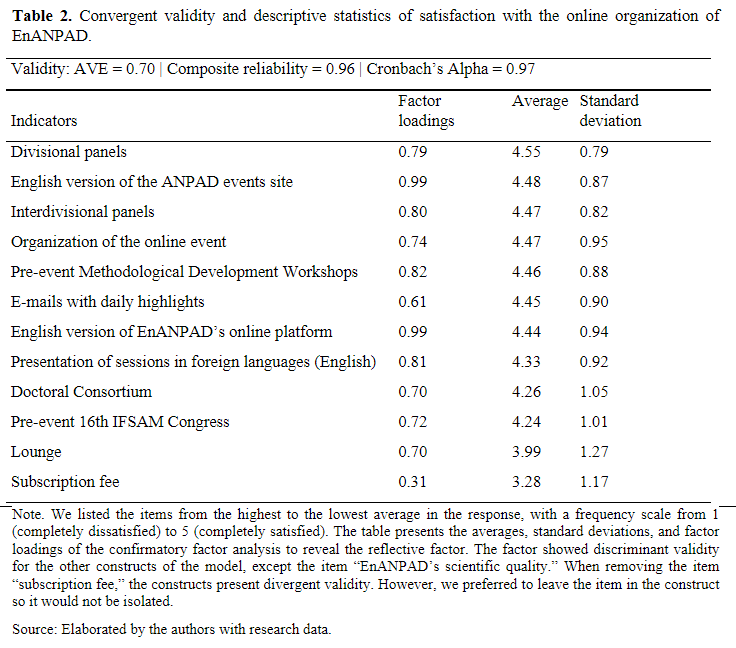
The second satisfaction construct was “satisfaction with the scientific quality.” The quality of the submission system, the general theme of EnANPAD, and the quality of the papers presented were the best–evaluated items. According to participants, it is important to improve the feedback authors receive from the audience in the paper presentation sessions. The evaluation of this item may be different in a face-to-face event since people may refrain from expressing themselves in the online modality.
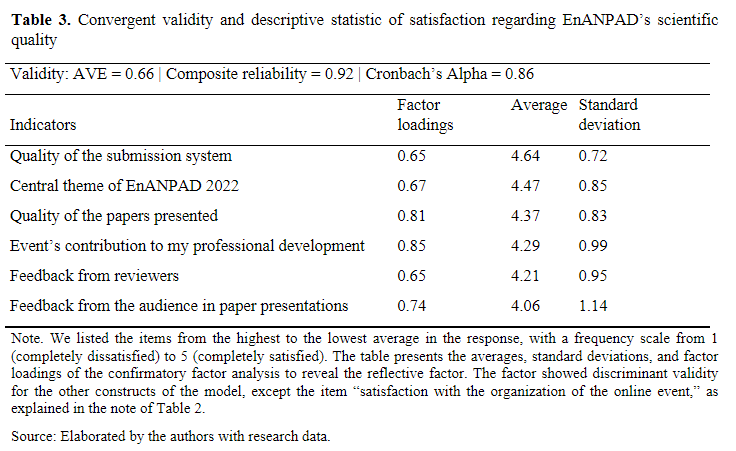
This edition included two items about the likelihood of recommending participating in EnANPAD to others, thus forming a new construct (Table 4). After confirming convergent validity, recommending EnANPAD encompasses a variety of situations. The responses indicated that the likelihood of professors recommending participation to students was stronger than participants recommending participation to foreign academics. However, this item presented a high score regarding the likelihood of recommending the event.

Figure 2 demonstrates the predictive path analysis from the construct “technical issues in the online platform” to the construct “EnANPAD recommendation” (direct relationships). Participants also indicated their desire for the online/face-to-face modality for the next EnANPAD (2023), with 32% wanting only the face-to-face modality, 37% the hybrid modality, and 31% only the online modality. Thus, we also measured the predictive path of recommending EnANPAD to others. The overall satisfaction of the event mediates all these. We used the constructs’ standardized scores and the isolated items’ standardized form.
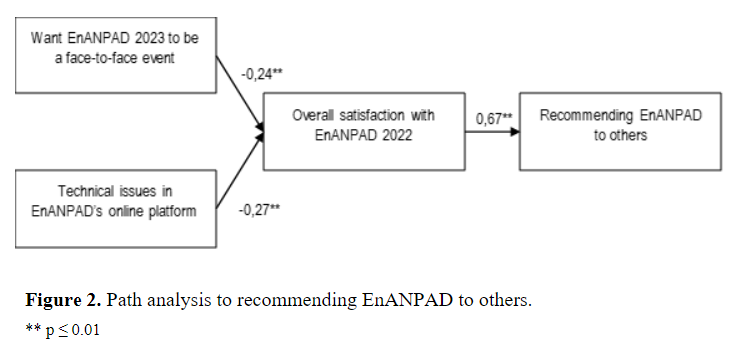
The greater the desire for the face-to-face modality of EnANPAD (B = -0.24; p ≤ 0.01), the lower the overall satisfaction with the event. Similarly, the more technical issues in the EnANPAD online platform (B = -0.27; p ≤ 0.01), the lower the overall satisfaction with EnANPAD. Both make sense since EnANPAD 2022 was held only in online mode. However, it was possible to perceive the effect of a greater magnitude of technical issues. The greater overall satisfaction of the event (B = 0.67; p ≤ 0.01) generates more recommendations.
Table 5 shows all estimates for recommending the event. The technical issues in the online platform and the desire to attend a face-to-face event totally and negatively impact the likelihood of recommending EnANPAD to others. Thus, the total variance explained in recommending EnANPAD was around 44%, indicating a medium effect. Other uninvestigated reasons may explain variations in recommending the event.
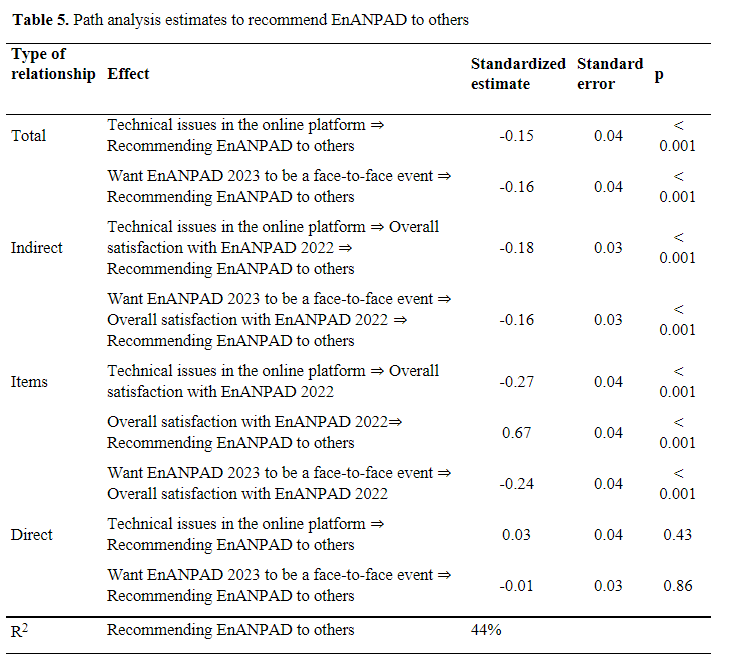
What else was good?
Participants reported positive aspects of the event in 2022. Figure 3 shows the similarity analysis and the connections of the terms of this attitude. Similar to the previous year, participants praised the event for the papers presented, the discussions of these works, the theme, diversity, and accessibility (online event). Participants demonstrated satisfaction with the online event, which was verified primarily by the compliments directed to the online platform and the divisional and interdivisional panels.
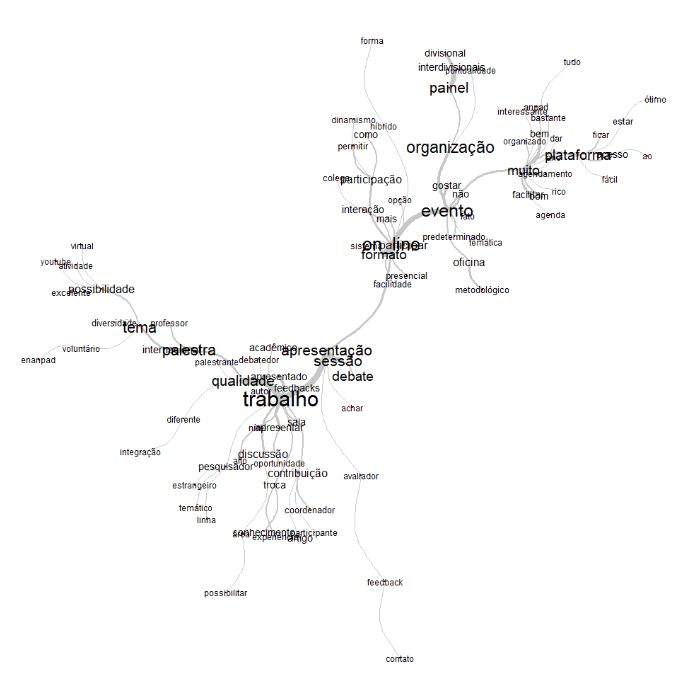
Figure 3. Similitude analysis of positive attitudes toward the event.
The terms entered by the survey respondents are in the original language.
Criticism and suggestions
We clustered the participants’ criticisms and suggestions (Figure 4) on four fronts. The first cluster referred mainly to the subscription fee charged for the online event. The design of a policy regarding the subscription fee for a more inclusive event than a face-to-face event proved to be a challenge to overcome. Participants mentioned that the fee would be fair if the event were face-to-face, at the same time as they recognized that such a modality would require increasing inclusion. The second concerns the doctoral consortium and methodological development workshops. Participants requested more inclusion and time for these activities. The third cluster refers to a lack of support for foreign lectures and language problems, with the suggestion of simultaneous translation. The fourth and final cluster of criticisms and suggestions focuses on paper presentation sessions. Participants mentioned needing more time to discuss the studies in depth. They suggest allotting more time for a better audience experience and recording the presentations and discussions, making them available to all participants. ANPAD can incorporate these criticisms into next year’s event.
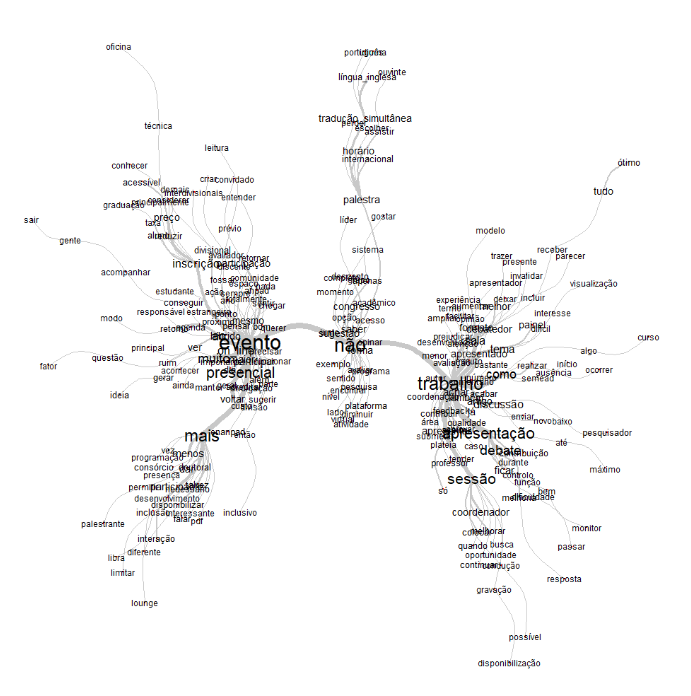
Figure 4. Similitude analysis of criteria and suggestions from participants
The terms entered by the survey respondents are in the original language.
Finally, we would like to thank everyone who participated in EnANPAD 2022. Their contribution to lectures, paper presentations, and the prestige offered to work developed in the academic community were fundamental for the event’s success. We have learned to innovate and overcome challenges related to hosting events of this magnitude. We hope the next EnANPAD will be even better, always counting on the contribution of the academic community.
Text written by Rafael Barreiros Porto (PPGA/UnB; ANPAD) and Kler Godoy (ANPAD).


